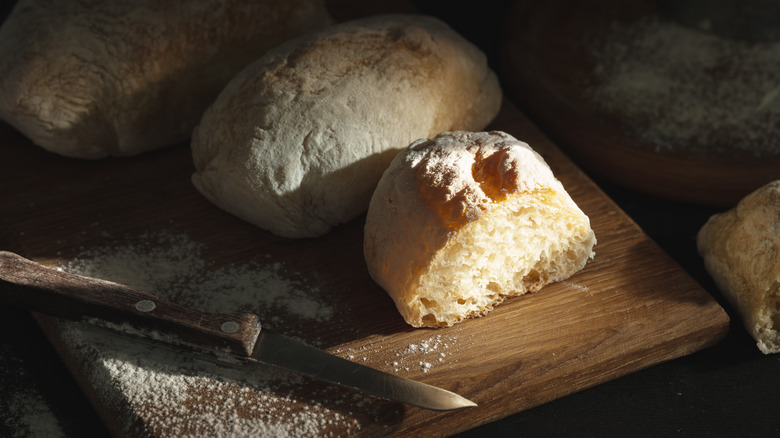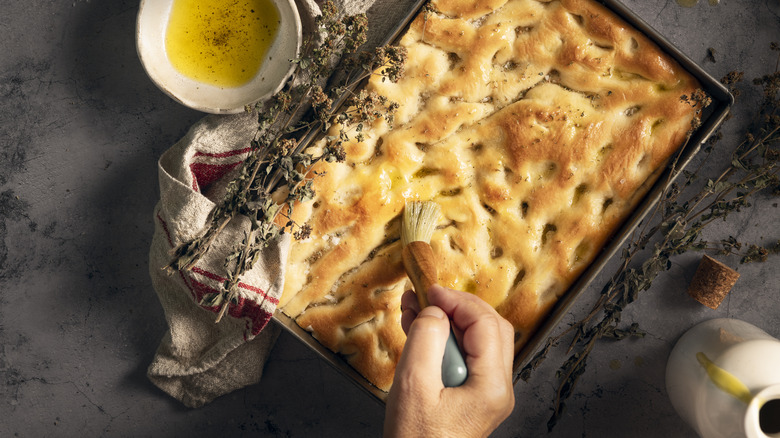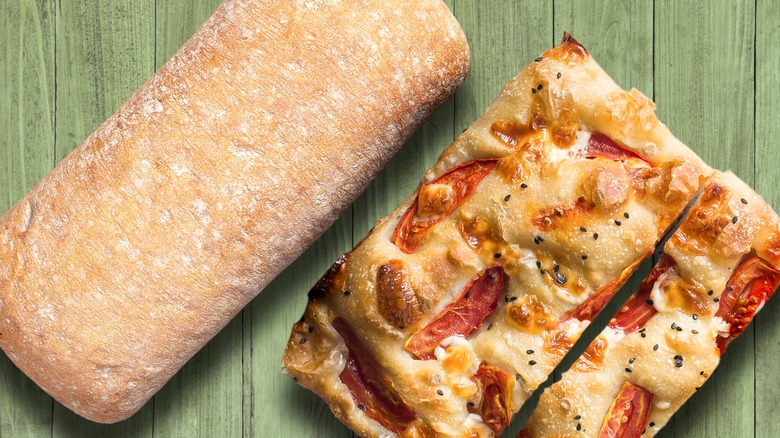Craving a journey into the realm of rustic Italian breads? We’re exploring two key players — ciabatta and focaccia — to determine what makes them unique. The most obvious difference between these two glutinous Italian classics is their textures. Where ciabatta has a fluffy and airy inner crumb with a crisp crust, focaccia is soft and spongy with a crunchy exterior and a far denser crumb structure.
Focaccia is also covered in a generous coating of olive oil, giving the bread a richer taste and a comparatively moist texture next to flour-coated ciabatta. Olive oil, a sprinkle of salt, and herbs (often rosemary) are typically the toppings on a traditional focaccia — its minimalist nature is often
why novice home bakers should start with focaccia
as opposed to ciabatta. The bread also comes together simply without complicated prep, whereas ciabatta requires a longer fermentation and multiple rising periods.
Also notably, ciabatta is baked into rustic loaves, whereas focaccia is baked into large, relatively flat slabs and sliced into pieces. Both can be used to make sandwiches, but ciabatta is pretty much exclusively enjoyed as a sandwich bread. We recommend using ciabatta as a base for an iconic breakfast sandwich or a
bacon and goat cheese frittata sandwich
. Alternatively, versatile focaccia is more commonly served as an appetizer or topped like a pizza. We also love using it in a
focaccia mortadella sandwich
or
loaded muffuletta grilled cheese
.
Read more:
17 Sourdough Bread Brands, Ranked Worst To Best
What Is Ciabatta?

Ciabatta is made from a straightforward combination of flour, water, yeast, and salt. Some preparations might also include olive oil, but this varies. The name “ciabatta” is etymologically derived from the Italian word for “slipper,” a nod to the bread’s slender and partially puffy shape. But, ciabatta can also be shaped into smaller buns, round or square.
A moisture content of up to 80% yields a sticky and highly hydrated dough, which can be tough to handle for new bakers in comparison to seasoned ciabatta bakers. For foodies willing to try their hand at making the bread, however, remember that
ciabatta is best made with a stand mixer
. Additionally, be aware that the dough also requires lengthy kneading and enough time to ferment and rise. Focaccia dough, by contrast, only has to proof for a couple of hours before it’s ready to bake.
The well-hydrated dough is what causes ciabatta to flatten underneath itself as it bakes, creating loaves without an ultra puffy rise. The inner crumb instead remains tender and light with an irregular shape, giving some chew alongside its outer crust. On the palate, ciabatta offers delicate flavors of wheat with a subtle tang from the fermentation that makes ciabatta a workhorse sandwich bread to complement any filling. To finish, ciabatta’s crust is customarily dusted in a light layer of flour, often a mixture of brittle semolina and rice flour.
What Is Focaccia?

Focaccia is much older than ciabatta. It traces back to the kitchens of ancient Romans and the Etruscans of Central Italy. Focaccia has been dominating the Mediterranean food scene for centuries, and sometimes you really can’t beat the classics. Making focaccia requires more numerous ingredients than ciabatta such as flour (preferably, high-gluten bread flour), water, yeast, olive oil, herbs, and any other toppings desired by the baker like thinly sliced vegetables or dried flowers. Still, for its lengthy ingredients list, focaccia’s actual assembly remains fairly uncomplicated.
Making
homemade focaccia is easy
. Pliable dough gets stretched and pressed into rectangular baking pans (1/2- to 1-inch thick) and left to rise. The surface of the bread is then dimpled with finger-sized indents that give focaccia its unique texture and create flavorful pockets for olive oil brushed over top. The pan is also greased with olive oil, facilitating 360 degrees of oil coverage for a golden result. This yields a forgiving dough that’s easy to handle and will prevent you from making any
big mistakes while baking focaccia.
Unlike mild ciabatta, focaccia is known for its decadent and distinctively savory taste, which becomes even more apparent with the addition of vegetables, herbs, or cheese lightly pressed into the bread’s surface. Other common toppings include earthy olives, tomatoes, and shallots. If you’re feeling ambitious, we invite you to take a few pointers from our
garden art vegetable focaccia recipe
.
Read the
original article on Tasting Table
.













